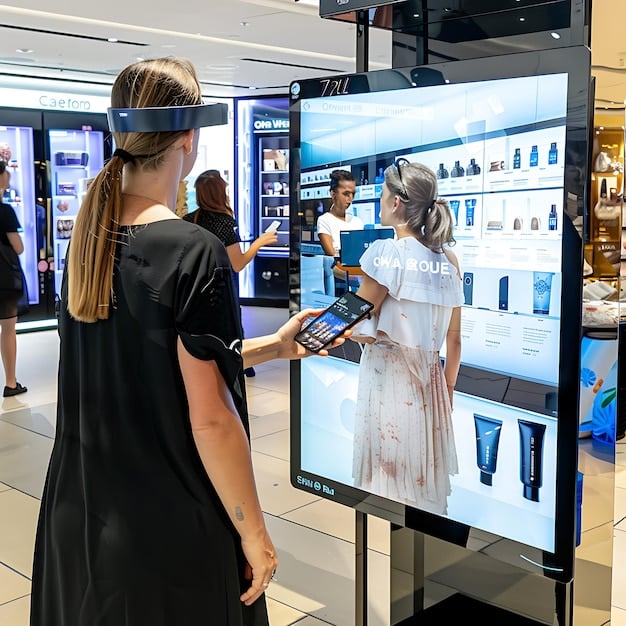The Future of Retail: How to Adapt to Consumer and E-Commerce Trends

The future of retail is being shaped by evolving consumer preferences and the ever-expanding e-commerce landscape, requiring retailers to adapt through innovative technologies, personalized experiences, and seamless omnichannel strategies to remain competitive.
The retail industry is undergoing a monumental transformation, driven by shifting consumer behaviors and the relentless growth of e-commerce. To thrive in this dynamic environment, businesses must understand and adapt to these changes. This article explores the future of retail: adapting to changing consumer preferences and e-commerce trends.
Understanding the Shifting Retail Landscape
The retail landscape is no longer defined by traditional brick-and-mortar stores. Consumers are increasingly turning to online channels for their shopping needs, influenced by convenience, broader product selections, and personalized experiences. Understanding these shifts is the first step in adapting to the future of retail.
Several factors contribute to the changing retail landscape, including:
- Technological Advancements: Innovations like artificial intelligence (AI), augmented reality (AR), and data analytics are reshaping how retailers operate and interact with customers.
- Changing Consumer Expectations: Consumers expect seamless, personalized, and convenient shopping experiences across all channels.
- E-commerce Dominance: Online platforms offer unparalleled reach and convenience, challenging traditional retail models.

The Rise of Omnichannel Retailing
Omnichannel retailing is a strategy that integrates all available channels—physical stores, e-commerce websites, mobile apps, and social media—to provide a consistent and unified customer experience. It’s no longer about choosing between online and offline shopping; it’s about blending the two.
Data-Driven Decision Making
Data analytics plays a crucial role in understanding consumer behavior and optimizing retail operations. By analyzing data on purchasing patterns, browsing behavior, and customer feedback, retailers can make informed decisions about product offerings, pricing strategies, and marketing campaigns.
In summary, the shifting retail landscape demands a proactive and adaptive approach. By understanding the key drivers of change and embracing strategies that cater to evolving consumer preferences, retailers can position themselves for success in the future.
Personalization: Tailoring the Customer Experience
Personalization is now a critical component of the retail experience. Consumers expect retailers to understand their individual needs and preferences, offering tailored product recommendations, personalized offers, and customized shopping experiences. Generic approaches are no longer sufficient; personalization drives engagement and loyalty.
Personalization can be implemented in various ways:
- Product Recommendations: Using algorithms to suggest products based on past purchases, browsing history, and demographic data.
- Personalized Offers: Offering discounts, promotions, and loyalty rewards based on individual customer behavior.
- Customized Content: Delivering tailored content, such as emails, newsletters, and website content, based on customer preferences.
AI-Powered Personalization
Artificial intelligence (AI) is revolutionizing personalization in retail. AI algorithms can analyze vast amounts of data to identify patterns and predict consumer behavior, enabling retailers to deliver hyper-personalized experiences.
The Role of Customer Data Platforms (CDPs)
Customer Data Platforms (CDPs) are essential for collecting, unifying, and analyzing customer data from various sources. CDPs enable retailers to create a single, comprehensive view of each customer, facilitating more effective personalization efforts.
Personalization is not just a trend; it’s a fundamental requirement for modern retail. By leveraging data and AI to deliver personalized experiences, retailers can enhance customer satisfaction, drive sales, and build long-term loyalty.
The Impact of Technology on Retail Operations
Technology is transforming retail operations, enhancing efficiency, improving customer service, and enabling new business models. From supply chain management to in-store experiences, technology is reshaping every aspect of retail operations.
Here are some key technological innovations impacting the retail industry:
- Inventory Management Systems: Real-time tracking of inventory levels to minimize stockouts and optimize supply chain efficiency.
- Point of Sale (POS) Systems: Streamlining transactions, managing sales data, and enhancing customer checkout experiences.
- Robotics and Automation: Automating tasks such as warehouse operations, order fulfillment, and in-store assistance.

Augmented Reality (AR) and Virtual Reality (VR)
Augmented Reality (AR) and Virtual Reality (VR) offer immersive shopping experiences that can enhance customer engagement and drive sales. AR allows customers to visualize products in their own environment, while VR offers virtual store tours and product demonstrations.
Blockchain Technology for Supply Chain Transparency
Blockchain technology provides a secure and transparent way to track products throughout the supply chain. This can help retailers ensure product authenticity, reduce fraud, and improve overall supply chain efficiency.
Technology is no longer just a support function in retail; it’s a core driver of innovation and competitive advantage. By embracing new technologies and integrating them into their operations, retailers can enhance efficiency, improve customer experiences, and drive growth.
E-commerce Trends: Beyond Online Shopping
E-commerce has evolved beyond simple online shopping. It now encompasses a wide range of trends and technologies that are reshaping how consumers discover, purchase, and interact with products and brands. Staying ahead of these trends is crucial for retailers looking to thrive in the digital age.
Key e-commerce trends include:
- Mobile Commerce (M-commerce): Optimizing the shopping experience for mobile devices, as more consumers use smartphones and tablets to make purchases.
- Social Commerce: Integrating shopping experiences into social media platforms, allowing consumers to discover and purchase products directly within their favorite apps.
- Voice Commerce: Enabling consumers to make purchases using voice assistants such as Amazon Alexa and Google Assistant.
The Growth of Subscription Services
Subscription services are becoming increasingly popular in e-commerce, offering consumers convenience and value through recurring deliveries of products. Retailers can leverage subscription models to build long-term customer relationships and generate recurring revenue.
The Importance of User Experience (UX)
User Experience (UX) is critical for e-commerce success. Retailers need to ensure that their websites and mobile apps are easy to use, visually appealing, and optimized for conversions. A seamless and intuitive UX can significantly improve customer satisfaction and drive sales.
E-commerce is a dynamic and ever-evolving landscape. By staying informed about the latest trends and technologies and adapting their strategies accordingly, retailers can continue to capture market share and drive growth in the digital world.
Sustainability and Ethical Retail Practices
Consumers are increasingly concerned about sustainability and ethical practices in retail. They want to support brands that are committed to environmental responsibility, fair labor practices, and sustainable sourcing. Retailers that prioritize these values can attract and retain customers who share their concerns.
Key aspects of sustainability and ethical retail include:
- Sustainable Sourcing: Ensuring that products are made from environmentally friendly materials and sourced from suppliers with ethical labor practices.
- Reducing Waste: Implementing measures to minimize waste throughout the supply chain, from production to packaging and delivery.
- Transparency and Traceability: Providing consumers with information about the origins and production processes of products.
The Circular Economy
The circular economy is a model that emphasizes reusing, recycling, and repurposing materials to minimize waste and reduce the environmental impact of production. Retailers can participate in the circular economy by offering product take-back programs, repair services, and resale platforms.
Consumer Demand for Transparency
Consumers are demanding greater transparency from retailers regarding their sustainability and ethical practices. Retailers can meet this demand by providing detailed information about their supply chains, environmental initiatives, and social responsibility efforts.
Sustainability and ethical practices are no longer optional for retailers; they are essential for building trust, attracting customers, and ensuring long-term success. By prioritizing these values and communicating their efforts transparently, retailers can create a positive impact on both the environment and their bottom line.
Building Brand Loyalty in a Competitive Market
In today’s competitive market, building brand loyalty is more critical than ever. Consumers have countless options, and retailers need to create compelling reasons for them to choose their brand over the competition. Brand loyalty drives repeat purchases, positive word-of-mouth referrals, and long-term customer relationships.
Strategies for building brand loyalty include:
- Exceptional Customer Service: Providing responsive, helpful, and personalized customer service experiences.
- Loyalty Programs: Offering rewards, discounts, and exclusive benefits to repeat customers.
- Community Building: Creating a sense of community around the brand through social media, events, and other engagement initiatives.
The Power of Storytelling
Storytelling is a powerful tool for building brand loyalty. Retailers can connect with consumers on an emotional level by sharing compelling stories about their brand’s history, values, and mission.
Engaging Through Social Media
Social media provides retailers with a platform to engage with customers, build relationships, and foster brand loyalty. Retailers can use social media to share content, answer questions, run contests, and solicit feedback.
Building brand loyalty requires a holistic approach that encompasses every aspect of the customer experience. By prioritizing customer satisfaction, building strong relationships, and creating a sense of community, retailers can cultivate loyal customers who will advocate for their brand.
| Key Point | Brief Description |
|---|---|
| 💡 Omnichannel Retailing | Integrate channels for a seamless customer journey. |
| 🎯 Personalized Experiences | Tailor offers and content using customer data. |
| 🛍️ E-commerce Growth | Embrace mobile, social, and voice commerce. |
| 🌿 Sustainability | Prioritize ethical practices and transparency. |
Frequently Asked Questions
▼
Omnichannel retailing integrates all available channels (physical stores, e-commerce websites, mobile apps) to provide a unified customer experience, blending online and offline shopping.
▼
Retailers can personalize experiences through product recommendations, tailored offers, and customized content based on customer data like past purchases and browsing history.
▼
Technology enhances efficiency, improves customer service, and enables new business models through real-time inventory management, streamlined POS systems, and automation.
▼
Sustainability addresses consumer concerns about environmental impact and ethical sourcing, helping retailers attract and retain customers who value responsible practices and transparency.
▼
Brand loyalty is built through exceptional customer service, loyalty programs, and community building. Storytelling and engaging social media presence are also key strategies for fostering connections.
Conclusion
Adapting to the changing consumer preferences and e-commerce trends is essential for the future of retail. By embracing innovation, prioritizing customer experience, and focusing on sustainability, retailers can position themselves for long-term success in a competitive market.





